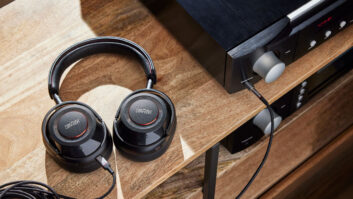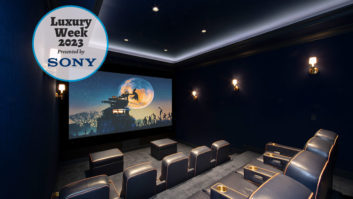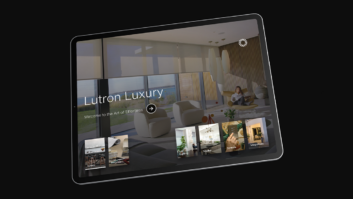Imagine a custom home theater with a massive screen, the best 4K projector on the market, and a meticulously engineered, 32-channel immersive sound system tuned to perfection. But beyond the state-of-the-art technology, there’s nothing in the room except for a few aluminum folding chairs. Would you sit through a whole movie?
OK, that’s an absurd illustration. But the point is that high-end clients who crave consummate technology usually demand it with style and comfort to match. And while no good custom integrator takes his eye away from the latest developments in the former, there’s plenty of innovation going on in the latter, as well.
Let’s start with seating. Following the trend of two-piece projection breaking free from the confines of purpose-built rooms and being integrated into multi-use spaces, manufacturers are developing solutions that can be at home in either setting.
Acoustic Innovations’ Curated Theaters packages combine laser-engraved, brass-covered grilles and furniture-grade finishes to provide an elegant movie-watching environment.
The WeatherHawk system enables homes to do things like adjust window coverings depending on the exact amount of solar radiation, and close storm shutters and retract awnings in high wind.
Available embedded in a variety of Jaymar’s furniture models, D-BOX immersive cinematic motion technology pitches and shakes viewers seats according to the action onscreen.
Fortress Seating’s Front Row Custom Sectional was designed in response to customer requests for reclining sectionals for the front row of dedicated theaters, and is equally at home in media rooms.
Bocce’s 87 Series lighting fixtures involve a matrix of hot glass that is stretched and folded back onto itself as it cools, resulting in a surrealist aesthetic.
CinemaTech sees lighting as a major influence in theater aesthetics, which emphasize clean lines. Among popular lighting trends are custom fiber optic ceiling lighting.
“We continue to see a high demand for seating for dedicated theaters,” said Gabi Wolper, vice president at Fortress Seating. “However, we are getting more requests for reclining sectionals for either the front row or media rooms as today’s consumers seek luxury seating options that fit their space and their unique needs for comfort, style, and convenience.”
For this purpose, the Fortress makes the Front Row Custom Sectional and West End Custom Sectional with motorized adjustable headrest, offering theater-pedigree seating for media rooms and versatility to dedicated theaters. And, according to Wolper, all of the company’s models can be customized to suit–from upholstery to accessories. “Popular choices include motorized headrests and footrests, pocket arms, USB ports and power outlets, and touchscreen mounts to enable convenient control of a smart home automation system,” she said.
For a more exhilarating motorized seat experience, there’s D-BOX chairs from Jaymar. For the past 12 years, the company has been partnered with the technology provider to bring a theme park ride experience into peoples’ homes. Available embedded in a variety of Jaymar’s furniture models–from sofas and loveseats to theater chairs–D-BOX immersive cinematic motion technology pitches and shakes viewers seats according to the action onscreen, creating a heightened connection to the film.
“Rich clients, they want the best,” said Mario Thibeault, vide president of business development at Jaymar Furniture. “So when they buy a theater, they want the best of what’s available. So a lot of the rich and famous clients are getting that option. But even if you’re rich, if your integrator doesn’t talk to you about it, then you won’t get it.”
The company is also developing a non-D-BOX motorized chair that integrates with Crestron and RTI control systems, with Control4 compatibility in the works. Expected for release sometime next year, Thibeault likens these chairs to another familiar seating experience. “Like in a car, you press a button for your favorite position,” he said. “It will adapt itself and go back to that position every time. It has never been done before on the furniture side.”
Like most luxury goods, high-end home theaters are more than just entertainment spaces; they’re status symbols that are meant to be shown off. At CEDIA last year, Acoustic Innovations–designer, manufacturer, and installer of home theater seating and accessories–launched its 25th Anniversary Curated Theaters collection to help movie lovers make a statement.
Available in three different styles–CINERialto, CINERitz, and CINECirque–the packages combine laser-engraved, brass-covered grilles, quality millwork, and furniture-grade finishes to create an elegant environment. The Curated Theaters collection’s theater column grilles are available in two sizes to accommodate various room heights.
“Columns add architectural balance and diffuse surfaces inside the theater,” said James Theobald, national sales director at Acoustic Innovations. “Another popular option is to place speakers inside the columns, which provides a mounting point for decorative grilles or sconces.”
Like Acoustic Innovations, CinemaTech’s business revolves around providing clients with overall solutions for a stylish screening room, from products like luxury seating models to all-around design services. Beyond customizable options for seating, the company is seeing lighting as a major influence on the aesthetics of today’s home theaters.
“Lighting has become a huge aspect to creating the right feel and function for each space,” said Michael Murphy, president of CinemaTech. “The spaces themselves are most often contemporary in style with very clean lines. The days of heavy red velvet curtains and ornate sconces have certain given way to the modern and chic styling of most homes designed today. Custom fiber optic ceilings have also become very popular. Lighting up the ceiling is a great way of enhancing the theater experience while also enhancing the acoustical performance of the theater.”
When it comes to lighting, theater solutions are just a tiny portion of the expertise that today’s integrators should possess. As LED lighting continues to grow in popularity, the opportunities to integrate low-voltage solutions into smart home projects are burgeoning. While not part of this aforementioned trend, German-Canadian company Bocci has seen the market potential in the custom integration industry, evidenced by its decision to exhibit at CEDIA last year.
[A Theater Worthy of the Seven Kingdoms]
The company, which is based in Berlin and Vancouver, specializes in lighting fixtures that double as bona fide works of art–the sort of thing luxury clients crave to make their living spaces stand out from their friends’. According to Johannes Christian Schön, communications director at Bocce, the company launched in 2005 with one piece, and has since grown an eclectic portfolio of work “focused mostly on the medium of light as it interacts with various artifacts produced through invented fabrication methods.”
For example, its 87 Series lighting fixtures involve a matrix of hot glass that is stretched and folded back onto itself as it cools, resulting in a surrealist aesthetic. “Air is trapped between the folds and stretched along the grain of the loop, creating microfilaments that give the piece a pearlescent optical quality,” according to company literature. “An LED light source is introduced at one end of the loop casting light through the microfilaments and registering a gentle gradient.” All Bocci pieces are developed, engineered, and fabricated in-house through an infrastructure that provides full control over concept, technique, quality, and scale.
Finally, for a residential accessory that provides homeowners with increased comfort and something novel to brag about, there’s WeatherHawk. Installed outside a home, it gathers data on wind speed and direction, outdoor air temperature, relative humidity, solar radiation, barometric pressure, and rainfall, then feeds it through OEM developed drivers to leading control systems, making climate control an autonomous process.
“WeatherHawk’s approach to home automation is to help the home owner control inside the home by what’s happening outside,” said Jeff Balls, WeatherHawk’s product manager. “Through home automation comes convenience and efficiency.”
According to the company, the system enables homes to do things like adjust window coverings depending on the exact amount of solar radiation, close storm shutters and retract awnings in high wind, and adjust irrigation systems based on rainfall levels.
The custom integration business is about far more than just providing the latest technology. The real value comes from delivering a luxury experience that can’t be purchased on Amazon or at Best Buy–an experience that blends electronic wizardry with high-class sophistication and turns a home into a statement.












